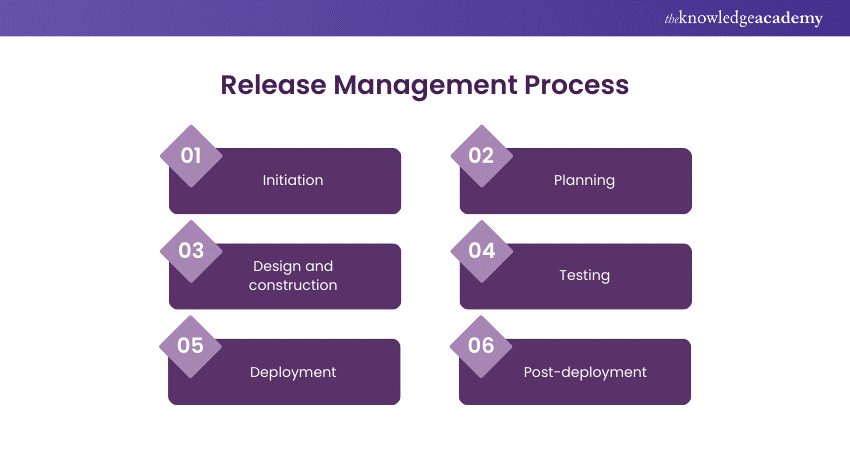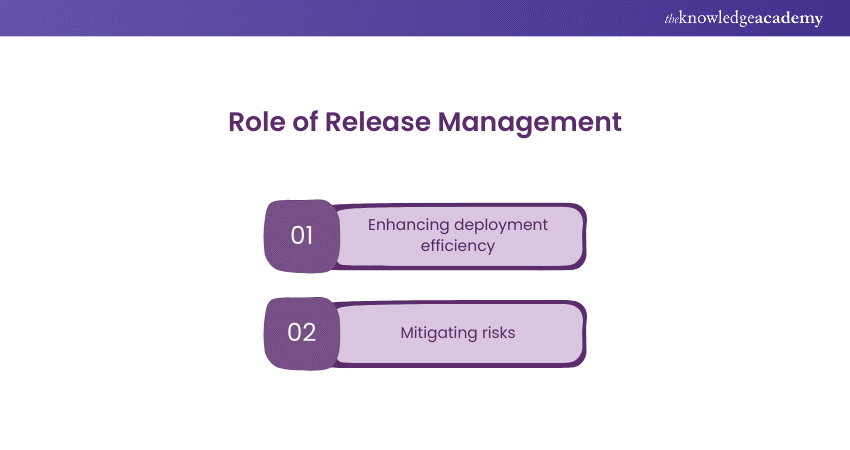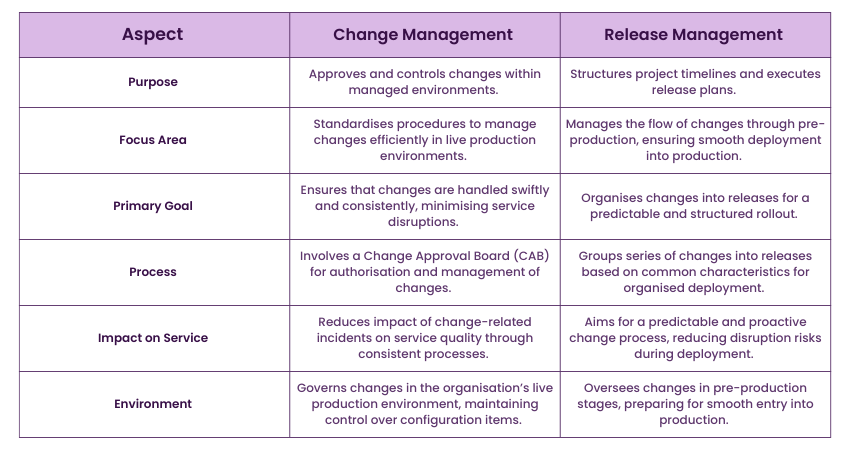We may not have the course you’re looking for. If you enquire or give us a call on +34 932716793 and speak to our training experts, we may still be able to help with your training requirements.
Training Outcomes Within Your Budget!
We ensure quality, budget-alignment, and timely delivery by our expert instructors.

Software Development is a complex and dynamic process that involves multiple teams, tools, and technologies. Ensuring customer satisfaction with high-quality software requires a clear and consistent approach to managing software releases. This is where Release Management comes in.
If you are curious to learn about Release Management and its processes, then this blog is for you. Dive in to learn more!
Table of Contents
1) What is Release Management?
2) 6 Steps to a Successful Release Management Process
3) What is Release Lifecycle Management?
4) History of Release Management
5) Release Management Process Structuring
6) Objectives and Advantages of Release Management
7) What is the Role of Release Management?
8) Indicators of effective Release Management
9) Change Management Vs Release Management
10) Conclusion
What is Release Management?
Release Management is the process of managing the software releases from the development stage to the production stage. It involves planning, scheduling, coordinating, testing, deploying, and monitoring software updates across different environments. Release Management aims to deliver software that is:
a) Reliable: The software works as expected and does not cause any errors or failures.
b) Secure: The software is protected from unauthorised access, modification, or damage.
c) Compliant: The software adheres to the organisation's and industry standards, regulations, and policies.
d) Compatible: The software works well with the existing systems, platforms, and devices.
e) User-friendly: The software provides a positive and satisfying experience for the users.
6 Steps to a Successful Release Management Process
The Release Management process is the activities and tasks performed to plan, execute, and monitor software releases. The Release Management process can vary depending on the software project's size, complexity, and nature. However, a typical Release Management process consists of the following phases:

1) Initiation
The initiation phase is the first step of the Release Management process. It involves defining the software release's scope, objectives, and requirements. It also involves identifying the release team's stakeholders, roles, and responsibilities. The initiation phase helps establish the software release's vision, purpose, and expectations.
2) Planning
The planning phase is the second step of the Release Management process. It involves creating a detailed plan for the software release, including the release schedule, budget, resources, risks, dependencies, and quality criteria. The planning phase helps to coordinate and align the activities and tasks of the release team. It also helps to communicate and document the release plan to the stakeholders.
3) Design and Construction
The design and construction phase is the third step of the Release Management process. It involves designing, developing, and building the software components of the software release. The design and construction phase helps implement the software release's features and functionalities. It also helps to ensure that the software components are consistent, modular, and reusable.
4) Testing
The testing phase is the fourth step of the Release Management process. It involves verifying and validating the software components of the software release. The testing phase helps to ensure that the software components are functional, reliable, secure, compliant, and compatible. It also helps identify and resolve software quality defects, errors, or issues.
5) Deployment
The deployment phase is the fifth step of the Release Management process. It involves delivering and installing the software components part of the software release to the target environments. The deployment phase helps to make the software available and accessible to the users. It also helps to ensure that the software components are integrated, configured, and optimised for the target environments.
6) Post-deployment
The post-deployment phase is the sixth and final step of the Release Management process. It involves monitoring and evaluating the software components that are part of the software release after they are deployed to the target environments. The post-deployment phase helps measure and improve the software's performance, usability, and satisfaction. It also helps to collect and analyse the software's feedback, metrics, and data.
What is Release Lifecycle Management?
While “Release Lifecycle Management” and “Release Management” may seem alike, they diverge in scope and purpose. Release lifecycle management encompasses a more comprehensive view of the release process, often touching on elements beyond direct release and deployment activities.
Release lifecycle management takes a broader approach, beginning at the earliest stages—perhaps when a release is first conceptualised—and extending until its relevance fades. For instance, a marketing-focused release might start with a strategic planning phase that kicks off long before any development work even begins.
Managing such an extensive process requires careful tracking across all phases. This involves allocating resources effectively and mapping out release and deployment windows on the calendar, ensuring each stage of the lifecycle is accounted for and seamlessly executed.
History of Release Management
Release Management has emerged as a crucial discipline within software engineering, evolving gradually as the industry’s focus shifted from isolated projects to ongoing product cycles.
Traditionally, developers viewed each release as a standalone project, rather than a continuous product journey with its own lifecycle. However, as development began to mirror a product lifecycle approach, releases were redefined not as endpoints but as critical transitions between support, iteration, and improvement.
This shift underscored the need for effective Release Management, fostering a seamless flow between each phase of the product journey. Technological advancements and evolving best practices have further propelled the significance of Release Management, making it a cornerstone in modern software development that aligns teams with product goals and long-term vision.
Release Management Process Structuring
The Release Management process can be structured differently depending on the organisation's and project's needs and preferences. Some of the common ways of structuring the Release Management process are:
1) Establishing Consistent Governance
Governance is the set of rules, policies, and standards that guide and control the Release Management process. Consistent governance helps ensure the Release Management process aligns with the organisational goals, values, and culture. It also helps to ensure that the Release Management process is transparent, accountable, and auditable.
2) Implementing Real-time Monitoring and Reporting
Monitoring and reporting collect, analyse, and present the information and data related to the Release Management process. Implementing real-time monitoring and reporting helps to track and measure the progress, performance, and quality of the software releases. It also helps to identify and address any issues, risks, or opportunities that may arise during the Release Management process.
3) Securing Requirements Traceability
Requirements traceability is the ability to link and track the software release requirements throughout the Release Management process. Securing requirements traceability helps ensure that the software release meets stakeholder expectations and needs. It also helps to ensure that the software release is consistent, complete, and accurate.
Objectives and Advantages of Release Management
The main objectives and advantages of Release Management are:
a) To deliver reliable, secure, compliant, compatible, and user-friendly software.
b) To improve the software delivery process's efficiency, effectiveness, and quality.
c) To reduce the costs, risks, and errors associated with the software delivery process.
d) To increase the satisfaction, trust, and loyalty of the customers and users.
e) To support the continuous improvement and innovation of the software.
Are you ready to take your Java programming abilities to the next level? Our comprehensive course in Java Programming and Software Engineering Fundamentals Training is your pathway to success!
What is the Role of Release Management?
Release Management plays a vital role in the software delivery process. Some of the key roles of Release Management are:

1) Enhancing Deployment Efficiency
Release Management helps to enhance the deployment efficiency by streamlining and automating the software delivery process. It helps to reduce the time, effort, and resources required to deploy the software updates to the target environments. It also helps to minimise the downtime, disruption, and impact of the software deployments on the current users.
2) Mitigating Risks
Release Management helps to mitigate the risks by identifying and managing the potential threats and challenges that may affect the software delivery process. It helps to prevent, detect, and resolve any issues, errors, or failures that may compromise the software quality. It also helps to ensure that the software releases comply with the standards, regulations, and policies of the organisation and the industry.
Indicators of effective Release Management
The effectiveness of Release Management can be measured using various indicators and metrics. Some of the common indicators of effective Release Management are:
1) Deployment Stays Within Budgetary Limits
The deployment budget is the amount allocated for the software delivery process. Effective Release Management ensures that the deployment stays within budgetary limits by optimising and controlling the costs of the software delivery process. It helps avoid unnecessary or wasteful expenses affecting the software project's profitability.
2) Minimal Impact on Current Users
The current users are people using the existing version of the software. Effective Release Management ensures that the deployment has minimal impact on the current users by minimising the downtime, disruption, and inconvenience caused by the software updates. It helps maintain the software's availability, functionality, and performance for the current users.
3) High Satisfaction Among New and Existing Users
The new and existing users are the people using the new version of the software. Effective Release Management ensures the deployment has high satisfaction among the new and existing users by delivering software that meets their needs and expectations. It helps to provide a positive and satisfying experience for the software users.
4) Adherence to Timeline Goals
The timeline goals are the deadlines and milestones of the software delivery process. Effective Release Management ensures that the deployment adheres to the timeline goals by managing and coordinating the activities and tasks of the software delivery process. It helps to avoid any delays, conflicts, or dependencies that may affect the timely delivery of the software.
Change Management Vs Release Management
Though Change Management and Release Management may appear similar and often share overlapping elements, they serve distinct purposes. Change management is centered on approving and controlling changes within a managed environment, often through a Change Approval Board (CAB). In contrast, Release Management focuses on structuring project timelines and executing release plans.

1) Change Management
Change Management’s primary goal is to establish standardised methods and procedures for handling changes swiftly and efficiently. It governs and introduces changes to an organisation’s live production environment, ensuring that any adjustments to configuration items are carefully managed. By following a consistent process, the team can minimise change-related incidents, protecting service quality from unintended disruptions.
2) Release Management
Release Management, on the other hand, is primarily concerned with the transition of changes through pre-production stages, leading to a successful deployment into the production environment. Changes are grouped into releases based on shared characteristics, enabling a smooth, structured release process. Release Management aims to make the process of implementing changes more predictable and proactive, reducing the risk of disruptions and fostering a more seamless change experience.
Discover the art of crafting exceptional Software with our Software Development Lifecycle Training and elevate your understanding of SDLC.
Conclusion
Release Management is a crucial aspect of the software delivery process. It helps to deliver reliable, secure, compliant, compatible, and user-friendly software. It also helps improve the software delivery process's efficiency, effectiveness, and quality. Release Management applies the principles of Servant Leadership to the software delivery process.
Unlock your potential in Software Testing with our comprehensive Software Testing Courses & Training programs - embark on a journey to become a skilled tester today!
Frequently Asked Questions

The five phases of Release Management are: Release Planning, Release Building, Release Testing, Release Preparing and Release Deploying.

Here are the common tools and techniques used for Release Management Release planning tools: Release Automation Tools, Release Orchestration Tools, Release Testing Tools, Release Monitoring Tools, Release Reporting Tools, Release Governance Tools and Release Traceability Tools.

The Knowledge Academy takes global learning to new heights, offering over 30,000 online courses across 490+ locations in 220 countries. This expansive reach ensures accessibility and convenience for learners worldwide.
Alongside our diverse Online Course Catalogue, encompassing 17 major categories, we go the extra mile by providing a plethora of free educational Online Resources like News updates, Blogs, videos, webinars, and interview questions. Tailoring learning experiences further, professionals can maximise value with customisable Course Bundles of TKA.

The Knowledge Academy’s Knowledge Pass, a prepaid voucher, adds another layer of flexibility, allowing course bookings over a 12-month period. Join us on a journey where education knows no bounds.

The Knowledge Academy offers various Software Engineering Courses, including Software Design Training and Software Development Lifecycle Training. These courses cater to different skill levels, providing comprehensive insights into SDLC In Software Testing.
Our Programming & DevOps Blogs cover a range of topics related to Release Management, offering valuable resources, best practices, and industry insights. Whether you are a beginner or looking to advance your Software Engineering skills, The Knowledge Academy's diverse courses and informative blogs have you covered.







 Top Rated Course
Top Rated Course




 If you wish to make any changes to your course, please
If you wish to make any changes to your course, please


